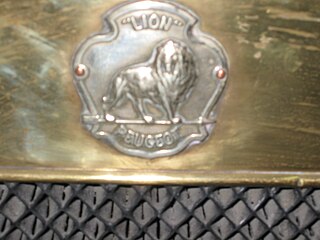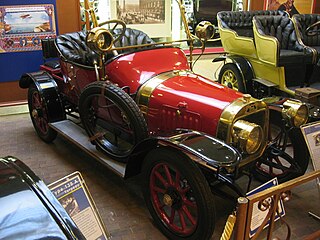
Armand Peugeot was a French industrialist, pioneer of the automobile industry and the man who transformed Peugeot into a manufacturer of bicycles and, later, of automobiles. He was accepted into the Automotive Hall of Fame in 1999.

The Peugeot Type 2 is the first petrol/gasoline-powered motor vehicle produced between 1890 and 1891 by the French auto-maker Peugeot at their Valentigney plant. The car was presented just two years after Armand Peugeot had split away from the Peugeot family business in order to concentrate on cars, with a separate Peugeot Automobiles business.
The Peugeot Type 21 is an early motor vehicle produced between 1898 and 1901 by the French auto-maker Peugeot at their Audincourt plant. Nine were produced.

The Peugeot Type 31 is an early motor vehicle produced between 1900 and 1902 by the French auto-maker Peugeot at their Audincourt plant. It was probably the smallest Peugeot ever offered for sale. Only 7 were produced.

The Peugeot Type 27 is an early motor vehicle produced between 1899 and 1902 by the French auto-maker Peugeot at their Audincourt plant. Only 29 were produced. This automobile had a brougham car body, similar to the older brougham carriage.

Lion-Peugeot is a formerly independent French auto-maker. It is the name under which in 1906 Robert Peugeot and his two brothers, independently of the established Peugeot car business, began to produce automobiles at Beaulieu near Valentigney.
The Peugeot Type 14 is an early motor car produced between 1897 and 1898 by the French auto-maker Peugeot at their Audincourt plant. First presented in public at the end of 1896 the Type 14 was the first new car introduction after Armand Peugeot’s new company “Automobiles Peugeot” had been registered, following formalisation of Armand's split from the then principal Peugeot business.

The Lion-Peugeot Type VA is an early motor car produced near Valentigney by the French auto-maker Lion-Peugeot between 1907 and 1908.

The Lion-Peugeot Type VC2 was an early motor car produced near Valentigney by the French auto-maker Lion-Peugeot between 1909 and 1910. 1,175 were produced.
The Lion-Peugeot Type VC3 was an early motor cars produced near Valentigney by the French auto-maker Lion-Peugeot in 1911. 135 were produced.
The Lion-Peugeot Type VY and the Lion-Peugeot Type VY2 were early motor cars produced near Valentigney by the French auto-maker Lion-Peugeot between 1908 and 1909.

The Lion-Peugeot Type V2C2 was early motor car produced near Valentigney by the French auto-maker Lion-Peugeot in 1910. By this time Lion-Peugeot had been producing motor cars for four years, but the V2C2 was the first model with an engine of more than one cylinder.
The Lion-Peugeot Type V2C3 was an early motor car produced near Valentigney by the French auto-maker Lion-Peugeot in 1911. It closely resembled the manufacturer’s Type V2C2 which it replaced. 520 V2C3s were produced.
The Lion-Peugeot Type V2Y2 was an early motor car produced near Valentigney by the French auto-maker Lion-Peugeot in 1910. It closely resembled the manufacturer's Type V2C2, but it had a larger engine and was faster. 300 V2Y2s were produced.
The Lion-Peugeot Type V2Y3 was a motor car produced near Valentigney by the French auto-maker Lion-Peugeot in 1911. It closely resembled the manufacturer's Type V2C3, but it had a larger engine and was faster. 215 V2Y3s were produced.

The Lion-Peugeot Type V4C3 was a motor car produced near Valentigney by the French auto-maker Lion-Peugeot between 1912 and 1913. It was the manufacturer's first car with a four-cylinder engine. 653 were produced.
The Lion-Peugeot Type VD was a motor car produced near Valentigney by the French auto-maker Lion-Peugeot in 1913. It was developed from the slightly smaller Lion-Peugeot Type V4C3 of the previous year. Approximately 800 Lion-Peugeot Type VDs were produced.
The Lion-Peugeot Type VD2 was a motor car produced near Valentigney by the French auto-maker Lion-Peugeot in 1915. It was usefully longer than the manufacturer's 1914 model, the Type V4D Approximately 480 Lion-Peugeot Type VD2s were produced. It was the last Lion-Peugeot produced before wartime economic conditions enforced the closure of Lion-Peugeot automobile production. Subsequent small Peugeots would be badged simply as Peugeots and produced in plants that had developed during the period, before 1910, when "Automobiles Peugeot" was a separate business.

The Peugeot Type 63 is an early motor car designed by Armand Peugeot and produced by the French auto-maker Peugeot at their Audincourt plant in 1904. 136 were produced, divided between shorter wheelbase Type 63As and longer wheelbase Type 63Bs.